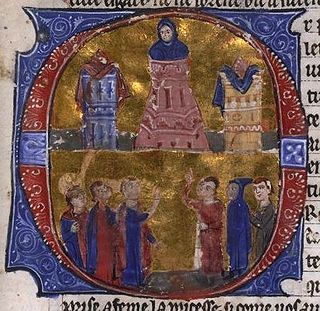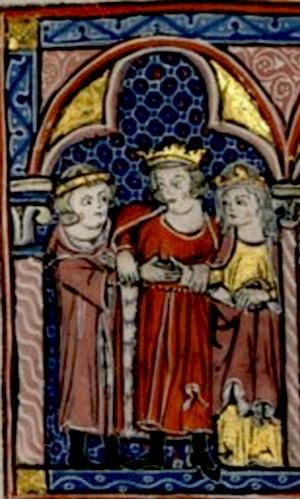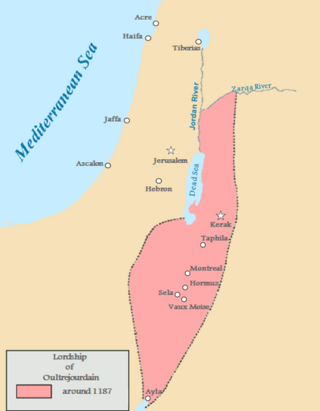
Amalric, formerly known in historiography as Amalric I, was the king of Jerusalem from 1163 until his death. He was, in the opinion of his Muslim adversaries, the bravest and cleverest of the crusader kings.

Baldwin I was the first count of Edessa from 1098 to 1100 and king of Jerusalem from 1100 to his death in 1118. He was the youngest son of Eustace II, Count of Boulogne, and Ida of Lorraine and married a Norman noblewoman, Godehilde of Tosny. He received the County of Verdun in 1096, but he soon joined the crusader army of his brother Godfrey of Bouillon and became one of the most successful commanders of the First Crusade.

Baldwin IV (1161–1185), known as the Leper King, was the king of Jerusalem from 1174 until his death in 1185. He was admired by his contemporaries and later historians for his willpower and dedication to the Kingdom of Jerusalem in the face of his debilitating leprosy. Choosing competent advisers, Baldwin ruled a thriving crusader state and succeeded in protecting it from the Muslim ruler Saladin.

Raynald of Châtillon, also known as Reynald, Reginald, or Renaud, was Prince of Antioch—a crusader state in the Middle East—from 1153 to 1160 or 1161, and Lord of Oultrejordain—a large fiefdom in the crusader Kingdom of Jerusalem—from 1175 until his death, ruling both territories iure uxoris. The second son of a French noble family, he joined the Second Crusade in 1147, and settled in Jerusalem as a mercenary. Six years later, he married Constance, Princess of Antioch, although her subjects regarded the marriage as a mesalliance.

Baldwin II, also known as Baldwin of Bourcq, was Count of Edessa from 1100 to 1118, and King of Jerusalem from 1118 until his death. He accompanied Godfrey of Bouillon and Baldwin of Boulogne to the Holy Land during the First Crusade. He succeeded Baldwin of Boulogne as the second count of Edessa when he left the county for Jerusalem following his brother's death. He was captured at the Battle of Harran in 1104. He was held first by Sökmen of Mardin, then by Jikirmish of Mosul, and finally by Jawali Saqawa. During his captivity, Tancred, the ruler of the Principality of Antioch, and Tancred's cousin, Richard of Salerno, governed Edessa as Baldwin's regents.

Isabella I reigned as Queen of Jerusalem from 1190 to her death in 1205. She was the daughter of Amalric I of Jerusalem and his second wife Maria Comnena, a Byzantine princess. Her half-brother, Baldwin IV of Jerusalem, engaged her to Humphrey IV of Toron. Her mother's second husband, Balian of Ibelin, and his stepfather, Raynald of Châtillon, were influential members of the two baronial parties. The marriage of Isabella and Humphrey was celebrated in Kerak Castle in autumn 1183. Saladin, the Ayyubid sultan of Egypt and Syria, laid siege to the fortress during the wedding, but Baldwin IV forced him to lift the siege.

Humphrey IV of Toron was a leading baron in the Kingdom of Jerusalem. He inherited the Lordship of Toron from his grandfather, Humphrey II, in 1179. He was also heir to the Lordship of Oultrejourdan through his mother, Stephanie of Milly. In 1180, he renounced Toron on his engagement to Isabella, the half-sister of Baldwin IV of Jerusalem. The king, who had suffered from leprosy, allegedly wanted to prevent Humphrey from uniting two large fiefs. Humphrey married Isabella in Kerak Castle in autumn 1183. Saladin, the Ayyubbid sultan of Egypt and Syria, laid siege to Kerak during the wedding, but Baldwin IV and Raymond III of Tripoli relieved the fortress.

The Kingdom of Jerusalem, one of the Crusader states that was created in 1099, was divided into a number of smaller seigneuries. According to the 13th-century jurist John of Ibelin, the four highest crown vassals in the kingdom proper were the count of Jaffa and Ascalon, the prince of Galilee, the lord of Sidon, and the lord of Oultrejordain.
Humphrey II of Toron was lord of Toron and constable of the Kingdom of Jerusalem. He was the son of Humphrey I of Toron.

The Battle of Montgisard was fought between the Kingdom of Jerusalem and the Ayyubid Dynasty on 25 November 1177 at Montgisard, in the Levant between Ramla and Yibna. The 16-year-old Baldwin IV of Jerusalem, severely afflicted by leprosy, led outnumbered Christian forces against Saladin's troops in what became one of the most notable engagements of the Crusades. The Muslim Army was quickly routed and pursued for twelve miles. Saladin fled back to Cairo, reaching the city on 8 December, with only a tenth of his army. Muslim historians considered Saladin's defeat to be so severe that it was only redeemed by his victory ten years later at the battles of Cresson and Hattin and the Siege of Jerusalem in 1187. Saladin did defeat Baldwin IV in the Battle of Marj Ayyun and the Siege of Jacob’s Ford in 1179, only to be defeated by Baldwin again at the Battle of Belvoir Castle in 1182 and the Siege of Kerak in 1183.

Montreal, or Qal'at ash-Shawbak in Arabic, is a castle built by the Crusaders and expanded by the Mamluks, on the eastern side of the Arabah Valley, perched on the side of a rocky, conical mountain, looking out over fruit orchards below. The ruins are located next to the modern town of Shoubak in Jordan.
Stephanie of Milly was the lady of Oultrejordain in 1169–1197 and an influential figure in the Kingdom of Jerusalem. She was also known as Stephanie de Milly, Etienette de Milly, and Etiennette de Milly. She married three times; firstly to Humphrey III of Toron, secondly to Miles of Plancy; her third and last husband was Raynald of Chatillon.

The Lordship of Transjordan was one of the principal lordships of the Kingdom of Jerusalem. It encompassed an extensive and partly undefined region to the east of the Jordan River, and was centered on the castles of Montreal and Kerak.
Philip of Milly, also known as Philip of Nablus, was a baron in the Kingdom of Jerusalem and the seventh Grand Master of the Knights Templar. He briefly employed the troubadour Peire Bremon lo Tort in the Holy Land.
Miles of Plancy was a French-born nobleman who rose to high offices in the Kingdom of Jerusalem. He arrived in the kingdom during the reign of his kinsman King Amalric, who appointed him seneschal in 1168. Miles accompanied the king on two campaigns in Egypt. In early 1174 the king arranged for Miles to marry a great heiress, Stephanie of Milly, which made Miles lord of Oultrejordain, one of the largest fiefs in the kingdom. Amalric died on 11 July 1174 and was succeeded by his minor son, Baldwin IV. A regent was not immediately appointed to rule in the boy king's name, and so Miles duly assumed the government in his capacity as seneschal. He was of a too imperious temperament to cooperate with other noblemen, however, and soon caused resentment that led to his murder.

The siege of Ascalon took place from 25 January to 22 August 1153, in the time period between the Second and Third Crusades, and resulted in the capture of the Fatimid Egyptian fortress by the Kingdom of Jerusalem. Ascalon was an important castle that was used by the Fatimids to launch raids into the Crusader kingdom's territory, and by 1153 it was the last coastal city in Palestine that was not controlled by the Crusaders.

Maria Komnene, Latinized Comnena, was the queen of Jerusalem from 1167 until 1174 as the second wife of King Amalric. She occupied a central position in the Kingdom of Jerusalem for twenty years, earning a reputation for intrigue and ruthlessness.

Kerak Castle is a large medieval castle located in al-Karak, Jordan. It is one of the largest castles in the Levant. Construction began in the 1140s, under Pagan and Fulk, King of Jerusalem. The Crusaders called it Crac des Moabites or "Karak in Moab", as it is referred to in history books. It was also colloquially referred to as Krak of the Desert.
Roman of Le Puy, also known as Romanus of Puy, was the first lord of Oultrejordain in the Kingdom of Jerusalem from around 1120 to around 1126. He was a nobleman from Auvergne who accompanied Adhemar de Monteil, Bishop of Le Puy, to the Holy Land during the First Crusade. He signed royal charters during the reign of King Baldwin I. Baldwin I or his successor, King Baldwin II, granted Roman the important fief of Oultrejordain, or its northern region. He was deprived of most of his domains because of a rebellion against Baldwin II. He and his son lost their remaining estates after they were accused of conspiring against Baldwin II's successor, King Fulk, in the early 1130s.
Pagan the Butler was lord of Oultrejordain in the Kingdom of Jerusalem from around 1126. He was first mentioned as the butler of Baldwin II of Jerusalem in 1120. He ordered the erection of Kerak Castle which became his seat in 1142.














